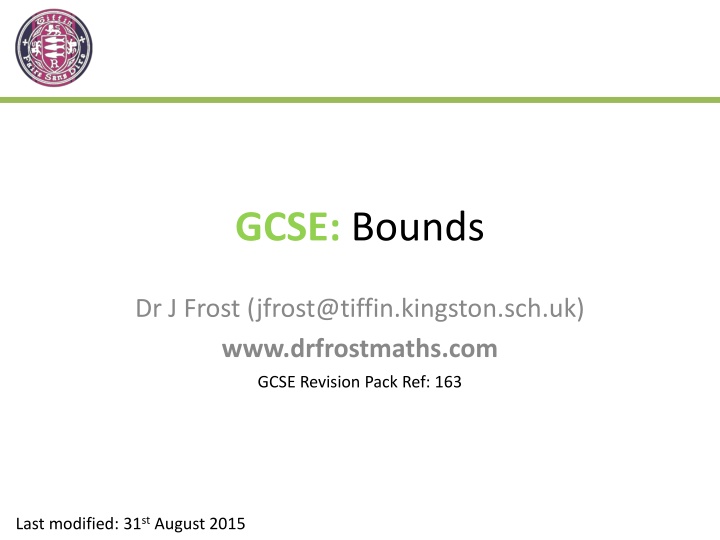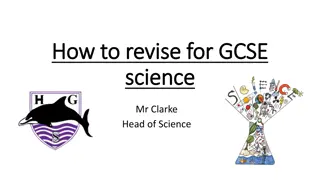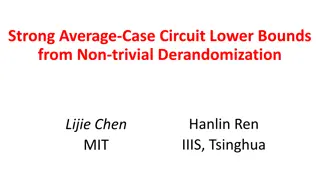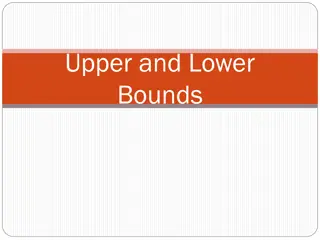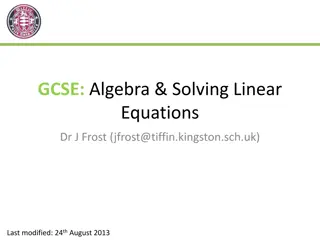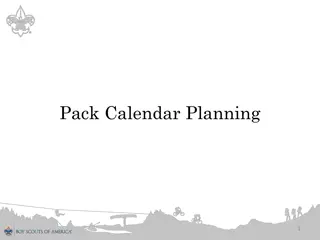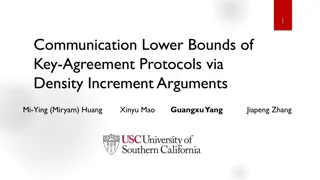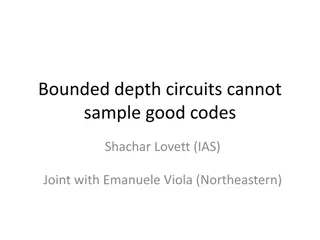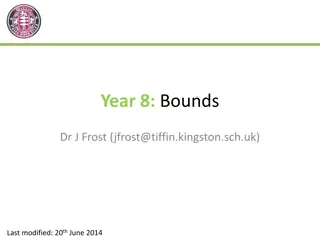GCSE Bounds Revision Pack
GCSE bounds concepts with exercises on significant figures, lower and upper bounds, and calculating areas within given accuracy levels. Understand the importance of considering bounds in mathematical calculations for precise results.
Download Presentation

Please find below an Image/Link to download the presentation.
The content on the website is provided AS IS for your information and personal use only. It may not be sold, licensed, or shared on other websites without obtaining consent from the author.If you encounter any issues during the download, it is possible that the publisher has removed the file from their server.
You are allowed to download the files provided on this website for personal or commercial use, subject to the condition that they are used lawfully. All files are the property of their respective owners.
The content on the website is provided AS IS for your information and personal use only. It may not be sold, licensed, or shared on other websites without obtaining consent from the author.
E N D
Presentation Transcript
GCSE: Bounds Dr J Frost (jfrost@tiffin.kingston.sch.uk) www.drfrostmaths.com GCSE Revision Pack Ref: 163 Last modified: 31st August 2015
Starter Write down the number 24.98063 to the following number of significant figures: ? ? ? ? ? 1sf 20 2sf 25 3sf 25.0 (the .0 is required!) 4sf 24.98 5sf 24.981 The length of a squirrel is measured as 14cm correct to the nearest cm. What is the smallest possible length the squirrel could be? What is the largest possible length? ? Smallest possible length: 13.5cm 14.5cm* ? Largest possible length: Recall that even though 14.5cm would round to 15cm, the upper bound 14.4 9 is equal to 14.5
Bounds Recap Work out the lower and upper bound for each value given the accuracy. ? To get bounds, add or subtract half the accuracy. Value 7cm 5.3m 200km 8.04mm Accuracy Nearest cm Nearest 0.1m Nearest 10km Nearest hundredth of a mm Nearest cm 2sf 3sf 1sf Lower Bound 6.5cm 5.25m 195km 8.035mm Upper Bound 7.5cm 5.35m 205km 8.045mm ? ? ? ? ? ? ? ? ? ? ? ? ? ? 3m 830 litres 830 litres 100 miles 2.995m 825 litres 829.5 litres 95m 3.005m 835 litres 830.5 litres 150m This is a really horrid one. You won t get this in an exam.
Bound Calculations 4? 30? The width of the rectangle is 30m correct to 1 significant figure. The height is 4m correct to the nearest metre. What is the greatest possible area of the rectangle? ?? ?.? = ???.??? What is the smallest possible area of the rectangle? ?? ?.? = ??.??? ? ?
Bound Calculations For each of these formulae, what would we use to calculate the lower and upper bounds? ? =? ? = ? ? ? ??????= ?????? ?????? ??????= ?????? ?????? ??????=?????? ??????=?????? ? ?????? ? ?????? ? = ? + ? ? ? ??????= ??????+ ?????? ??????= ??????+ ?????? 1 ? = ? ? = ? ? 1 ? ??????= ?????? 1 ?????? ? ? ? ??????= ?????? ?????? ??????= ?????? ?????? ??????=
Typical GCSE question ? ? = ? ? = 3.47 correct to 2 decimal places. ? = 8.132 correct to 3 decimal places. By considering bounds, work out the value of ? to a suitable degree of accuracy. You must show all your working and give a reason for your final answer. ??????= 3.465 ??????= 3.475 ??????= 8.1315 ??????= 8.1325 Find bounds of each variable ? ?????? ?????? ?????? ?????? 3.465 8.1325= 0.2288903 3.475 8.1315= 0.2292486 ??????= Use to find bounds of ? ? = ??????= = If we had to only choose a single value for ?, what would be most sensible? The most accurate value possible such that all values in the range ?????? to ?????? would round to this. ? ? = 0.229 as both the lower bound and upper bound are this to 3dp . Final value of ? and why ?
Practicing that last step In each case you re trying to find a single suitable value of ? to use (with justification), and you ve calculated the upper and lower bounds. ??????= 148343 ??????= 151033 ? ??????= 15.6241 ??????= 15.5935 ? ? = 150 000 as both upper and lower bounds are this to 2sf. ? = 15.6 as both upper and lower bounds are this to 1dp. ??????= 4.95013 ??????= 4.94502 ? ??????= 1.29584 ??????= 1.29545 ? ? = 4.95 as both upper and lower bounds are this to 2dp. ? = 1.30 as both upper and lower bounds are this to 2dp.
Test Your Understanding ? =?2 ? ? = 2.87 correct to 2 decimal places. ? = 3.584 correct to 3 decimal places. Work out the value of ? to a suitable degree of accuracy, giving a reason for your answer. ??????=?.???? ??????=?.???? ?.????= ?.????????? ? ?.????= ?.?????? So ? = ?.? to ???/??? as both bounds are the same to this level of accuracy.
Exercises ? = ? ?. ? = 4.5 correct to 1 decimal place. ? = 3.68 correct to 2 decimal places. Work out the lower and upper bound of ?. ??????= ?.?? ?.??? = ??.????? ??????= ?.?? ?.??? = ??.????? [Edexcel March 2012] The average fuel consumption ? f a car, in km/litre, is given by the formula: ? =? 4 1 ? Where ? is the distance travelled, in km, and ? is the fuel used, in litres. ? = 163 correct to 3sf. ? = 45.3 correct to 2sf. By considering bounds, work out the value of ? to a suitable degree of accuracy. You must show all of your working and given a reason for your final answer. 3.6 because the LB and UB agree to that number of figures. ? ? [Edexcel June 2013] Dan does an experiment to find the value of ?. He measures the circumference ? and the diameter ? of a circle. ? = 170?? to the nearest mm. ? = 54?? to the nearest mm. Dan uses ? =? ? to find ?. Calculate the upper and lower bound for ?. ??????=???.? ??.?= ?.?? ??????=???.? ??.?= ?.?? 2 5 Given ? ? = ? And that ? = 2546?? correct to the nearest km and ? = 13.4?? correct to the 1dp, find ? to a suitable degree of accuracy. ??????= ?.????????? ??????= ?.????????? ? = ?.?? because both bounds are this to 2dp. ? ? ? =?2 3 ? If ? = 7.5?? correct to 1dp and ? = 13?? correct to the nearest cm, then find the upper and lower bound of ?. ??????=?.??? ??.?= ??.?? ??????=?.??? ??.?= ??.? Given: ? = ? ? and that ? is 12.3m correct to 1dp and ? is 3.14m correct to 2dp, find ? to a suitable degree of accuracy. ??????= ??.?? ?.??? = ??.????? ??????= ??.?? ?.??? = ??.????? ? = ?? as both values are the same to 1sf. ? 6 ?
